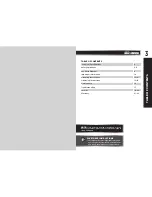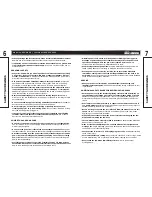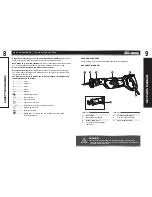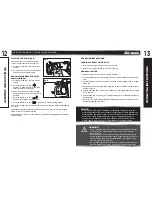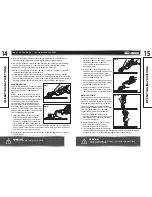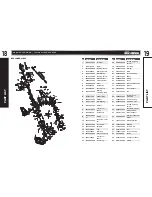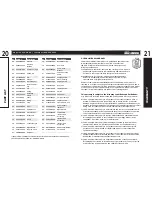
7
6
model no. 054-8146-8 | contact us 1.800.689.9928
• when operating a power tool outdoors, use an extension cord suitable for outdoor
use.
Use of a cord suitable for outdoor use reduces the risk of electric shock.
• If operating a power tool in a damp location is unavoidable, use a ground-fault
circuit interrupter (gfCI) protected supply.
Use of a GFCI reduces the risk of
electric shock.
PeRSONAL SAfeTY
• Stay alert, watch what you are doing and use common sense when operating
a power tool. Do not use the tool while tired or under the influence of drugs,
alcohol, or medication.
A moment of inattention while operating power tools
may result in serious personal injury.
• Use personal protective equipment. Always wear eye protection.
Protective
equipment such as dust mask, non-skid safety shoes, hard hat, or hearing
protection, used for appropriate conditions, will reduce personal injuries.
• Prevent unintentional starting. ensure the switch is in the off-position before
connecting to power source and/or battery pack, picking up or carrying the
tool.
Carrying power tools with your finger on the switch or energising power
tools that have the switch on invites accidents.
• Remove any adjusting key or wrench before turning the power tool on.
A
wrench or a key left attached to a rotating part of the power tool may result in
personal injury.
• Do not overreach. Keep proper footing and balance at all times.
This enables
better control of the power tool in unexpected situations.
• Dress properly. Do not wear loose clothing or jewellery. Keep your hair,
clothing and gloves away from moving parts.
Loose clothes, jewellery or long
hair can be caught in moving parts.
• If devices are provided for the connection of dust extraction and collection
facilities, ensure that these are connected and properly used.
Use of these
devices can reduce dust-related hazards.
POweR TOOL USe AND CARe
• Do not force the power tool. Use the correct power tool for your application.
The correct power tool will do the job better and more safely at the rate for
which it was designed.
• Do not use the power tool if the switch does not turn it on and off.
Any power
tool that cannot be controlled with the switch is dangerous and must be repaired.
• Disconnect the plug from the power source and/or the battery pack from the
power tool before making any adjustments, changing accessories, or storing
power tools.
Such preventive safety measures reduce the risk of starting the
power tool accidentally.
• Store idle power tools out of the reach of children and do not allow persons
unfamiliar with the power tool or these instructions to operate the power tool.
Power tools are dangerous in the hands of untrained users.
• Maintain power tools. Check for misalignment or binding of moving parts,
breakage of parts and any other condition that may affect the power tool’s
operation. If damaged, have the power tool repaired before use.
Many
accidents are caused by poorly maintained power tools.
• Keep cutting tools sharp and clean.
Properly maintained cutting tools with
sharp cutting edges are less likely to bind and are easier to control.
• Use the power tool, accessories, tool bits, etc. in accordance with these
instructions, taking into account the working conditions and the work to be
performed.
Use of the power tool for operations different from those intended
could result in a hazardous situation.
SeRVICe
• Have your power tool serviced by a qualified repair person using only
identical replacement parts.
This will ensure that the safety of the power tool
is maintained.
ADDITIONAL SAfeTY RULeS fOR ReCIPROCATINg SAwS
• Hold the power tool by the insulated gripping surfaces when performing an
operation where the cutting accessory may contact hidden wiring or its own
cord.
If a cutting accessory contacts a “live” wire, it may make the exposed
metal parts of the power tool “live” and could give the operator an electric
shock.
• Use clamps or another practical way to support the workpiece and secure it
to a stable platform.
Holding the work by hand or against your body leaves it
unstable and may lead to loss of control.
• before starting to cut, turn the tool “ON” and allow the blade to come to full
speed.
The tool can chatter or vibrate if the blade speed is too slow at the
beginning of cut and could kickback.
• Always disconnect the tool from the power source before changing the saw
blade and/or adjusting the saw base.
• The saw blade must be securely locked in its holder.
Check that the blade has
been securely seated before use.
• Make certain that all adjusting screws and the blade holder are tight before
making a cut.
Loose adjusting screws and holders can cause the tool or blade
to slip and loss of control may result.
• Check that the switch is “off” before plugging the tool in.
Accidental starting
could cause injury.
• Secure material before cutting.
Never hold it in your hand or across legs. Small
or thin material may flex or vibrate with the blade, causing loss of control.
• Never touch the saw blade immediately after use.
It may be hot after
prolonged use.
S
A
fe
TY
g
UID
e
LIN
e
S
S
A
fe
TY
g
UID
e
LIN
e
S


